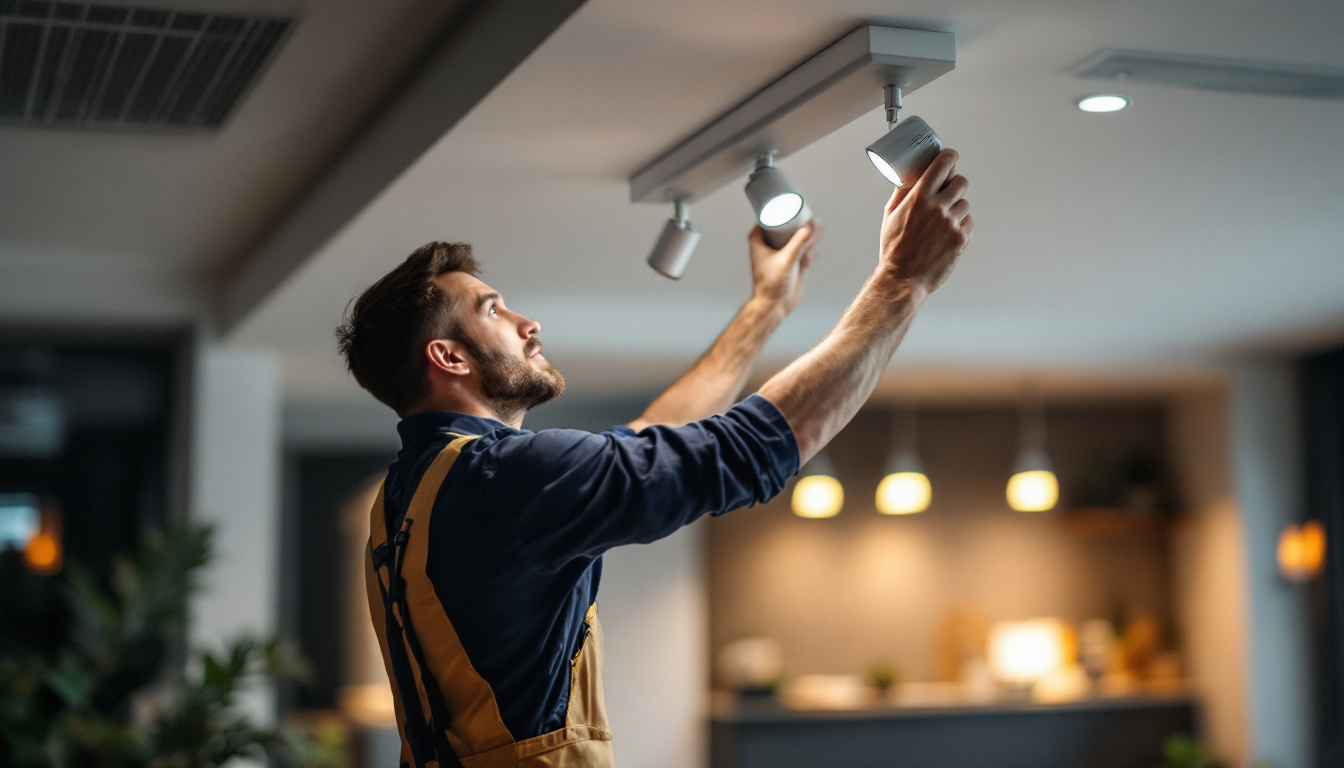
In the ever-evolving world of lighting solutions, the integration of technology into traditional systems has become paramount. Among these advancements, occupancy sensors stand out as a crucial component for modern lighting contractors. These devices not only enhance energy efficiency but also improve the overall user experience. However, not all lighting contractors are created equal when it comes to implementing these technologies. This article delves into what sets top lighting contractors apart in the realm of occupancy sensors.
Occupancy sensors play a vital role in optimizing energy consumption in both residential and commercial settings. By automatically turning lights on and off based on room occupancy, these sensors help reduce electricity costs and minimize environmental impact. Understanding their significance is essential for lighting contractors who wish to remain competitive in the industry.
One of the primary benefits of occupancy sensors is their ability to significantly lower energy bills. By ensuring that lights are only on when needed, these devices contribute to substantial savings over time. For contractors, demonstrating these savings to potential clients can be a powerful selling point. Clients are increasingly looking for solutions that not only enhance their spaces but also align with sustainability goals. Furthermore, the integration of occupancy sensors into smart home systems allows for even greater control and efficiency, enabling homeowners to monitor and adjust their energy usage remotely. This advanced connectivity not only appeals to tech-savvy clients but also positions contractors as forward-thinking professionals in the evolving landscape of energy management.
Beyond energy savings, occupancy sensors improve the user experience by providing convenience and safety. In commercial spaces, for instance, employees can move freely without worrying about manually switching lights on and off. This seamless experience can lead to increased productivity and satisfaction. Top lighting contractors recognize the importance of user-centric solutions, ensuring that their installations cater to the needs of the end-users. Additionally, the use of occupancy sensors can enhance security measures; for example, lights can automatically illuminate pathways when someone enters a building after hours, deterring potential intruders and providing peace of mind to occupants. As businesses prioritize employee safety and comfort, the demand for such intelligent lighting solutions continues to grow, making it crucial for contractors to stay informed about the latest technologies and trends in occupancy sensing.
Not all occupancy sensors are created equal. Quality sensors come equipped with various features that enhance their functionality and effectiveness. Understanding these features can help lighting contractors make informed decisions when selecting products for their projects.
Occupancy sensors can be categorized into several types, including passive infrared (PIR), ultrasonic, and dual-technology sensors. Each type has its unique advantages and is suited for different applications. For example, PIR sensors are ideal for detecting motion in small areas, while ultrasonic sensors can cover larger spaces and detect even the slightest movements. A knowledgeable contractor understands these distinctions and can recommend the best type of sensor based on the specific needs of a project. Additionally, dual-technology sensors combine both PIR and ultrasonic technologies, providing a more reliable detection method by minimizing false triggers and ensuring that lights are only activated when necessary. This versatility makes them a popular choice for diverse environments, from retail spaces to conference rooms.
Quality occupancy sensors often come with adjustable sensitivity settings and time delay options. These features allow contractors to customize the performance of the sensor according to the environment it is installed in. For instance, in a busy office, a shorter time delay may be appropriate to ensure lights turn off quickly when a room is vacated. In contrast, a longer time delay may be beneficial in less frequented areas. Tailoring these settings can enhance the effectiveness of the sensor and improve user satisfaction. Moreover, some advanced models offer adaptive sensitivity, which adjusts automatically based on the level of activity detected in the space over time. This can lead to significant energy savings and a more comfortable environment for occupants, as the lights will respond dynamically to changing conditions.
As smart home and building technologies continue to gain traction, the ability of occupancy sensors to integrate with these systems becomes increasingly important. Top contractors are well-versed in products that offer seamless integration with smart lighting, HVAC, and security systems. This capability not only enhances the functionality of the sensors but also positions contractors as forward-thinking professionals who can provide comprehensive solutions to clients. Furthermore, integration with smart systems often allows for remote monitoring and control, enabling building managers to analyze usage patterns and optimize energy consumption effectively. This level of connectivity not only improves operational efficiency but also contributes to sustainability efforts by reducing unnecessary energy waste, aligning with the growing demand for eco-friendly solutions in modern construction and renovation projects.
The installation of occupancy sensors requires a thorough understanding of both the technology and the environment in which it will be used. Top lighting contractors excel in this area by adhering to best practices that ensure optimal performance and longevity of the sensors.
One of the most critical aspects of installing occupancy sensors is their placement. Sensors should be positioned to maximize their effectiveness, taking into account factors such as furniture layout, ceiling height, and potential obstructions. A skilled contractor will conduct a thorough assessment of the space before installation, ensuring that the sensors can accurately detect occupancy without interference. Additionally, it is important to consider the type of occupancy that will be detected; for example, different settings may require adjustments in sensitivity to account for varying levels of movement, such as in a busy office versus a quiet conference room. By tailoring the placement and sensitivity settings to the specific needs of the environment, contractors can significantly enhance the functionality of the sensors.
After installation, testing and calibration are essential steps that top contractors do not overlook. This process involves verifying that the sensors function correctly and adjusting settings as necessary. By conducting thorough tests, contractors can identify any issues early on and ensure that the system operates as intended. This attention to detail can significantly enhance client satisfaction and reduce the likelihood of service calls in the future. Moreover, it is beneficial to educate clients on how to interact with their new systems, including how to manually override settings if needed and how to interpret any indicator lights or alerts. Providing this knowledge empowers clients to make the most of their occupancy sensors and fosters a sense of confidence in the technology. Additionally, routine maintenance checks can be recommended to ensure the sensors continue to perform optimally over time, further extending their lifespan and effectiveness.
For many clients, the concept of occupancy sensors may be new or misunderstood. Top lighting contractors take the time to educate their clients about the benefits and functionalities of these devices, fostering trust and confidence in their services.
One effective way to educate clients is through demonstrations. By showcasing how occupancy sensors work in a real-world setting, contractors can illustrate the immediate benefits of the technology. Whether it’s a live demonstration in a showroom or a virtual presentation, providing clients with a tangible understanding of the product can lead to more informed purchasing decisions.
In addition to demonstrations, providing comprehensive documentation can further enhance client understanding. This may include user manuals, installation guides, and maintenance tips. Top contractors also offer ongoing support, ensuring that clients feel confident in their ability to operate and maintain the system. This level of service can set a contractor apart in a competitive market.
The lighting industry is constantly evolving, with new technologies and trends emerging regularly. Top lighting contractors prioritize staying informed about these changes to remain competitive and provide the best solutions to their clients.
Investing in continuous education and training is crucial for contractors looking to stay ahead. This may involve attending industry conferences, participating in workshops, or enrolling in online courses. By expanding their knowledge, contractors can better understand the latest advancements in occupancy sensor technology and how to implement them effectively.
Networking with other industry professionals can also provide valuable insights into emerging trends and best practices. By building relationships with manufacturers, suppliers, and other contractors, top lighting professionals can share knowledge and resources that enhance their service offerings. This collaborative approach leads to a more informed and innovative industry as a whole.
In the competitive landscape of lighting contracting, the integration of occupancy sensors is a significant differentiator. Top lighting contractors understand the importance of these devices and excel in their implementation, installation, and client education. By focusing on energy efficiency, user experience, and staying updated with industry trends, they position themselves as leaders in the field.
Ultimately, the ability to provide comprehensive solutions that incorporate advanced technologies like occupancy sensors not only enhances a contractor’s reputation but also contributes to a more sustainable future. As the demand for smart lighting solutions continues to grow, those who invest in their knowledge and skills will undoubtedly reap the rewards in a rapidly changing market.
Ready to elevate your lighting projects with the latest in occupancy sensor technology? Look no further than LumenWholesale for a selection that combines quality with affordability. We provide contractors with spec-grade lighting products at unbeatable wholesale prices, ensuring you have access to the most reliable and high-performance lighting solutions for your clients. Plus, with the convenience of free shipping on bulk orders, you can stock up on the best lighting products without worrying about hidden fees. Don’t compromise on quality or value—choose LumenWholesale for your lighting needs and experience the perfect blend of quality, affordability, and convenience. Visit our website to browse our Wholesale Lighting at the Best Value and start making a difference in your projects today.

Discover why outdoor wall mount lighting fixtures are essential tools for lighting contractors.

Discover essential tips and expert insights for lighting contractors looking to master T8 LED lighting installations.

Discover how LED track lights are transforming the lighting industry and giving contractors a competitive edge.

Discover the essential guide to commercial electric can lights tailored for lighting contractors.